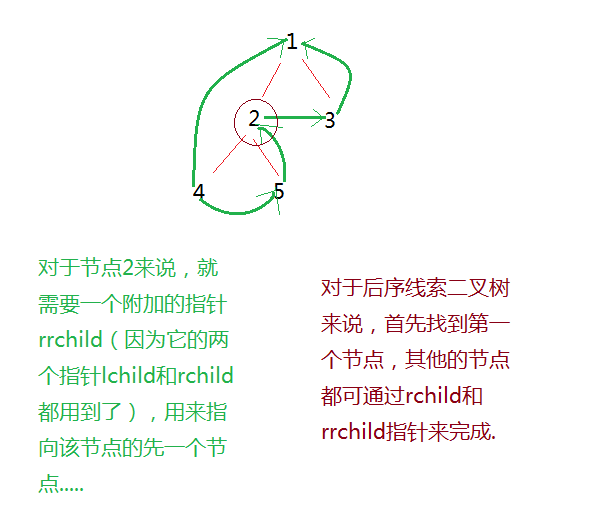//后序线索,这种方法不容易想到
#include<iostream>
#include<cstring>
#include<cstdio>
#include<algorithm>
using namespace std;
struct TREE{
int val;
TREE *ch[2];
TREE *thread;//该节点的线索的下一个节点
TREE(){}
TREE(int val){
this->val = val;
ch[0] = ch[1] = NULL;
thread = NULL;
}
};
void buildT(TREE * &T){
int x;
scanf("%d", &x);
if(x == -1) return ;
T = new TREE(x);
buildT(T->ch[0]);
buildT(T->ch[1]);
}
void postThread(TREE *T, TREE *pre){
if(!T) return;
postThread(T->ch[0], T);
postThread(T->ch[1], T);
if(pre){
if(pre->ch[0] == T && pre->ch[1])//T是左子树
T->thread = pre->ch[1]; //T的下一个节点就是它的兄弟节点
else //T是右子树
T->thread = pre;//T的下一个节点就是它 的父亲节点
}
}
void printT_pre(TREE *T){//前序打印
if(!T) return ;
printf("%d ", T->val);
printT_pre(T->ch[0]);
printT_pre(T->ch[1]);
}
void printT_Thread(TREE *T){//后序线索打印
TREE *root = T;
bool flag = true;//表明T所在的字数没有访问过
while(1){
while(flag && T->ch[0]) T = T->ch[0];
printf("%d ", T->val);
if(T->thread->ch[0] == T || T->thread->ch[1] == T)
flag = false;//如果 T没有兄弟节点了,就一直沿着它的父节点向上走
else flag = true;
T = T->thread;
if(T == root){//再次回到最顶端父节点时, 结束!
printf("%d ", T->val);
break;
}
}
}
int main(){
TREE *T = NULL;
buildT(T);
printT_pre(T);
printf("\n");
postThread(T, NULL);
printT_Thread(T);
printf("\n");
return 0;
}下面是基本按照同样的套路实现二叉树的先序,中序,后序的线索
//先序线索
#include<stdio.h>
#include<stdlib.h>
#define Thread 1
#define Tlink 0
typedef struct tree
{
int d;
struct tree* lchild;
struct tree* rchild;
int Ltag, Rtag;
}*TREE;
void build_tree(TREE &T)
{
int d;
scanf("%d", &d);
if(d!=-1)
{
T=(TREE)malloc(sizeof(tree));
T->d=d;
T->lchild=T->rchild=NULL;
T->Ltag=T->Rtag=Tlink;
build_tree(T->lchild);
build_tree(T->rchild);
}
}
TREE pre;
void preThread_tree(TREE p)
{
if(p)
{
if(!p->lchild)
{
p->lchild=pre;
p->Ltag=Thread;
}
if(!pre->rchild)
{
pre->rchild=p;
pre->Rtag=Thread;
}
pre=p;
if(p->Ltag==Tlink)//考虑到只有一个结点或两个节点情况,
preThread_tree(p->lchild);//如果没有 if语句可能出现死循环
if(p->Rtag==Tlink)
preThread_tree(p->rchild);
}
}
void print_preThr_tree(TREE T)
{
TREE p=T;
while(1)
{
while(p->Ltag==Tlink)
{
printf("%d ", p->d);
p=p->lchild;
}
printf("%d ", p->d);
p=p->rchild;
if(p==T) break;
while(p->Rtag==Thread)
{
printf("%d ", p->d);
p=p->rchild;
}
}
}
void print_tree(TREE T)
{
if(T)
{
printf("%d ", T->d);
print_tree(T->lchild);
print_tree(T->rchild);
}
}
int main()
{
TREE T=NULL;
build_tree(T);
print_tree(T);//递归先序遍历
printf("\n");
pre=T;
preThread_tree(T);//非递归先序遍历
pre->rchild=T;
print_preThr_tree(T);
return 0;
}//中序线索
#include<stdio.h>
#include<stdlib.h>
#define Thread 1
#define Tlink 0
typedef struct tree
{
int d;
struct tree* lchild;
struct tree* rchild;
int Ltag, Rtag;
}*TREE;
void build_tree(TREE &T)
{
int d;
scanf("%d", &d);
if(d!=-1)
{
T=(TREE)malloc(sizeof(tree));
T->d=d;
T->lchild=T->rchild=NULL;
T->Ltag=T->Rtag=Tlink;
build_tree(T->lchild);
build_tree(T->rchild);
}
}
TREE pre;
void inorThread_tree(TREE p)
{
if(p)
{
if(p->Ltag==Tlink)//当只有一个结点的时候,要加上这句话
inorThread_tree(p->lchild);
if(!p->lchild)
{
p->lchild=pre;
p->Ltag=Thread;
}
if(!pre->rchild)
{
pre->rchild=p;
pre->Rtag=Thread;
}
pre=p;
if(p->Rtag==Tlink)
inorThread_tree(p->rchild);
}
}
/*
上述代码可以简化如下,pre的初值为NULL就好
void inorThread_tree(TREE p)
{
if(p)
{
inorThread_tree(p->lchild);
if(!p->lchild)
{
p->lchild=pre;
p->Ltag=Thread;
}
if(pre && !pre->rchild)
{
pre->rchild=p;
pre->Rtag=Thread;
}
pre=p;
inorThread_tree(p->rchild);
}
}
*/
void print_tree(TREE T){
if(T)
{
print_tree(T->lchild);
printf("%d ", T->d);
print_tree(T->rchild);
}
}
void print_inorThr_tree(TREE T)
{
TREE p=T;
while(1)
{
while(p->Ltag==Tlink)
p=p->lchild;
printf("%d ", p->d);
while(p->Rtag==Thread)
{
p=p->rchild;
printf("%d ", p->d);
}
p=p->rchild;
if(p==T)
break;
}
}
int main()
{
TREE T=NULL;
build_tree(T);
print_tree(T);//递归中序遍历
printf("\n");
pre=T;
inorThread_tree(T);//非递归中序遍历
pre->rchild=T;
pre->Rtag=0;//保证只有一个结点的情况
print_inorThr_tree(T);
return 0;
}
//后序线索
#include<stdio.h>
#include<stdlib.h>
#define Thread 1
#define Tlink 0
typedef struct tree
{
int d;
struct tree* lchild;
struct tree* rchild;
struct tree* rrchild;
int Ltag, Rtag;
}*TREE;
void build_tree(TREE &T)
{
int d;
scanf("%d", &d);
if(d!=-1)
{
T=(TREE)malloc(sizeof(tree));
T->d=d;
T->lchild=T->rchild=NULL;
T->Ltag=T->Rtag=Tlink;
build_tree(T->lchild);
build_tree(T->rchild);
}
}
TREE pre;
void postThread_tree(TREE p)
{
if(p)
{
if(p->Ltag==Tlink)
postThread_tree(p->lchild);
if(p->Rtag==Tlink)
postThread_tree(p->rchild);
if(!p->lchild)
{
p->lchild=pre;
p->Ltag=Thread;
}
if(!pre->rchild )
{
pre->rchild=p;
pre->Rtag=Thread;
} else {
pre->rrchild=p;
}
pre=p;
}
}
void print_postThr_tree(TREE T)
{
TREE p=T;
while(p->Ltag==Tlink)
p=p->lchild;
while(1)
{
printf("%d ", p->d);
if(p==T)
break;
if(p->Rtag == Thread)
p=p->rchild;
else
p=p->rrchild;
}
}
void print_tree(TREE T)
{
if(T)
{
print_tree(T->lchild);
print_tree(T->rchild);
printf("%d ", T->d);
}
}
int main()
{
TREE T=NULL;
build_tree(T);
print_tree(T);//递归后序遍历
printf("\n");
pre=T;
postThread_tree(T);//非递归后序遍历
pre->rchild=T;
pre->Rtag = Thread;
print_postThr_tree(T);
return 0;
}



